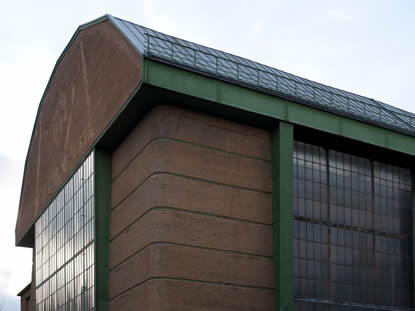Peter Behrens – AEG Electricity Company Buildings
A juxtaposition of current and rediscovered historical images
The rapid growth that led to Berlin’s electrical industry becoming that industry’s most important European centre began at the end of the 19th century. The foremost feature of the "Electropolis" Berlin was the array of buildings erected by the electrical companies Siemens, AEG (Allgemeine Elektricitäts Gesellschaft – "General Electricity Company") and its affiliate BEW (Berliner Elektricitätswerke – "Berlin Electrical Works").
A significant part of the planning and construction of the administration building, industrial facilities and company housing fell to the architect and designer Peter Behrens (1868-1940). In 1907 he was appointed the company’s "Künstlerischer Beirat" (artistic consultant) and thereby became responsible for all aspects of AEG´s corporate image.
To this day, his industrial buildings continue to be dominant features of Berlin’s cityscape. Despite that prominence, however, there is today very little knowledge of the present condition of those factory and residence buildings.
The Berlin architect and photographer Carsten Krohn has documented for the first time all the work that Behrens undertook on behalf of AEG. Twenty of his most recent colour photographs graphically depict the present state of those buildings.
Their historical status, on the other hand, is chronicled by seventeen until now unpublished black-and-white vintage prints from the AEG archives that, since 1997, have been administered by the Historical Archive at the Stiftung Deutsches Technikmuseum.
From Wedding to Hennigsdorf and all the way to Riga
The exhibition focuses on the AEG buildings by Peter Behrens that still stand today. These include the AEG turbine factory in Berlin-Moabit (built 1908-09), the NAG building in Berlin-Oberschöneweide (1915-17) and the apartment houses for AEG employees in Hennigsdorf (1910-11). The AEG factory in Riga (1913), the building complex of which serves today as a commercial centre, is also shown for the first time in its current guise.
The historical images that Krohn has set in opposition to his present-day photographs come from Stiftung Deutsches Technikmuseum´s archives, which provided Krohn with the opportunity to consult an extensive collection of original contemporary AEG prints, some of which had never been published. The photo exhibit of the turbine factory in Berlin-Moabit (1908), for instance, had never before been seen in this aspect. This comparative study is further enriched by vintage prints from the 1920s made by the contemporary architectural photographer Emil Leitner, including, for example, the AEG High Tension Factory in Berlin-Wedding (1909-10) and the AEG Locomotive Factory in Hennigsdorf (1913).
The Photographer and Curator Carsten Krohn
Carsten Krohn studied architecture, art history, and urban planning in Hamburg and at Columbia University, New York.
He worked as an architect for Norman Foster’s architectural firm and, in 2004, wrote his Art History doctoral dissertation on the historical impact of Buckminster Fuller. In addition, he has held teaching positions at the Universität Karlsruhe, Humboldt-Universität and the TU Berlin. In 2010 he was the curator of the exhibition "Das ungebaute Berlin (The unbuilt Berlin)" at the Café Moskau in Berlin.
He is the author of the illustrated book "Peter Behrens – Architektur", in which all the buildings built by Peter Behrens are catalogued and displayed. In the book, the present-day buildings are juxtaposed with images from their historical past. Krohn´s presentation of Behrens´ work, which runs from art nouveau to classicism and expressionism to "Neues Bauen (New Architecture)", is distinguished by his keen eye for detail and formal references.
